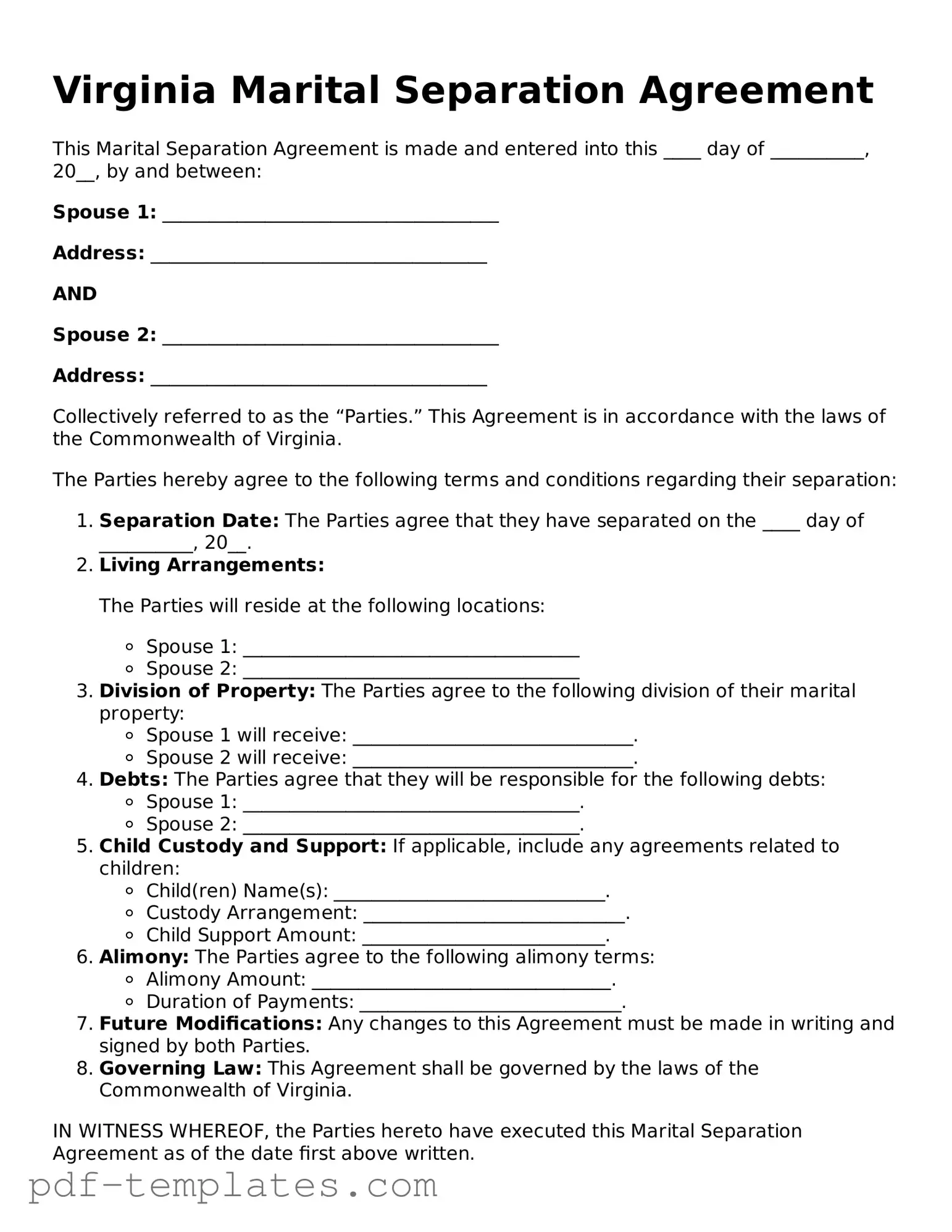The Virginia Marital Separation Agreement is similar to a Divorce Settlement Agreement. Both documents outline the terms of a couple's separation, including division of assets, custody arrangements, and support obligations. While a Marital Separation Agreement is used when couples wish to live apart without immediately filing for divorce, the Divorce Settlement Agreement is finalized when the couple has decided to end their marriage legally. Both documents aim to provide clarity and structure to the separation process.
Another document akin to the Virginia Marital Separation Agreement is the Property Settlement Agreement. This document specifically focuses on the division of property and debts between spouses. While the Marital Separation Agreement may cover various aspects of the separation, including child custody and support, the Property Settlement Agreement hones in on financial matters, ensuring that both parties understand their rights regarding marital assets.
The Custody Agreement is also similar to the Virginia Marital Separation Agreement. This document specifically addresses the custody and visitation arrangements for children involved in a separation. While the Marital Separation Agreement may include custody provisions, the Custody Agreement provides a more detailed framework for parenting responsibilities, schedules, and decision-making authority regarding the children.
In certain situations, individuals may find themselves needing to assert their rights and seek remedies for infringements, which can be accomplished through formal requests such as a cease and desist letter. Utilizing resources like All Florida Forms can provide essential guidance in drafting this document, helping to ensure that all necessary legal elements are included to effectively communicate the demand for cessation of unwanted actions.
A Separation Agreement is another document that closely resembles the Virginia Marital Separation Agreement. This term is often used interchangeably with the Marital Separation Agreement. It serves the same purpose: to outline the rights and responsibilities of each spouse during the separation period. Both documents are designed to protect the interests of both parties while they navigate their separation.
The Non-Marital Cohabitation Agreement is similar in that it outlines the rights and responsibilities of individuals living together without being married. Like the Marital Separation Agreement, it addresses property division and financial responsibilities. However, it is specifically tailored for couples who are not legally married but want to establish clear terms for their relationship.
The Prenuptial Agreement also shares similarities with the Virginia Marital Separation Agreement. While a Prenuptial Agreement is established before marriage to outline asset division in the event of divorce or separation, both documents aim to clarify financial rights and responsibilities. They serve to protect individual interests and provide a roadmap for potential future disputes.
The Child Support Agreement is another document that aligns with the Virginia Marital Separation Agreement. This document specifically addresses the financial responsibilities of each parent toward their children. While the Marital Separation Agreement may include child support provisions, the Child Support Agreement focuses solely on the financial aspects, ensuring that children's needs are met following the separation.
The Spousal Support Agreement is also comparable to the Virginia Marital Separation Agreement. This document outlines the financial support one spouse may provide to the other after separation. While the Marital Separation Agreement may address various aspects of the separation, the Spousal Support Agreement specifically focuses on the maintenance of one spouse’s financial well-being.
The Mediation Agreement is another document that can be similar to the Virginia Marital Separation Agreement. This document is created as a result of mediation sessions where both parties discuss and negotiate the terms of their separation. While the Marital Separation Agreement may be drafted after negotiations, the Mediation Agreement serves as a record of the discussions and agreements reached during mediation, which can then be formalized into a separation agreement.
Finally, the Settlement Agreement in a Family Law case can be compared to the Virginia Marital Separation Agreement. This document is used to resolve disputes in family law cases, including separation and divorce. It encompasses various aspects such as asset division, child custody, and support obligations, similar to the Marital Separation Agreement, but is often the result of negotiations during legal proceedings.
